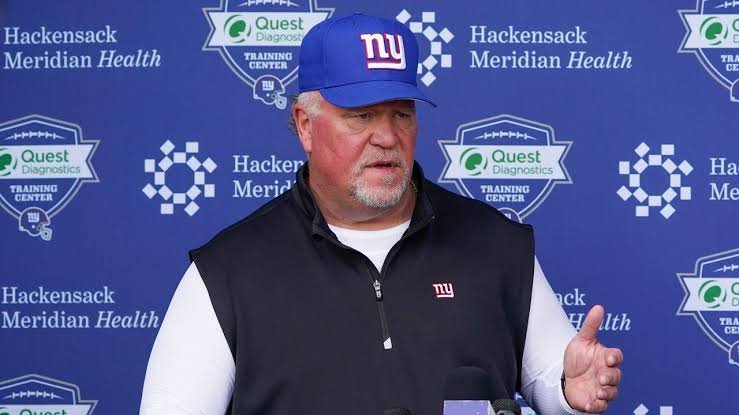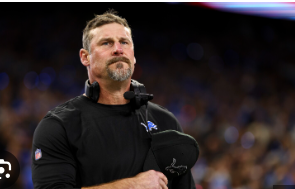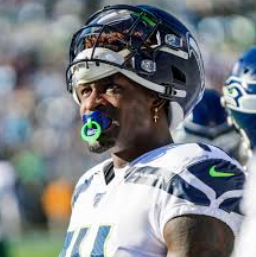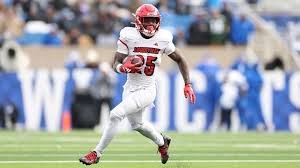
**The New York Giants’ Struggles Under a Head Coach on Fire: A Tactical Breakdown**
The New York Giants, a storied franchise in the National Football League (NFL), have long been known for their resilience, legendary players, and hard-nosed football. However, in recent seasons, the team has been grappling with a string of disappointing performances, and at the heart of this struggle is their head coach. While the blame for the team’s underperformance cannot be solely placed on one individual, the tactical decisions made by the coaching staff have been a significant factor in the team’s downward trajectory. The current head coach, whose strategies have increasingly come under scrutiny, finds himself in the eye of a storm, facing mounting pressure to turn the ship around.
### **The Rise of the Head Coach**
Before diving into the tactical missteps, it’s important to understand the context in which the head coach rose to prominence. When the Giants hired their current coach, they were hopeful that a fresh approach would bring the team back to playoff contention. The coach, whose experience had primarily been in offensive coordination, was expected to revamp a stagnant offense and bring a modern, aggressive style of play to a franchise that had long struggled to keep pace with the high-flying offenses that dominated the NFL.
Early signs seemed promising. His reputation for innovative playcalling and his ability to develop young quarterbacks were seen as the perfect recipe for the Giants, who were looking to transition to a new era. However, the team’s recent performances have painted a very different picture, one where the head coach’s tactical approach has come into question.
### **The Offensive Struggles: A Lack of Creativity**
One of the most glaring tactical problems has been the underperformance of the offense. Despite possessing talented players, including a promising quarterback, the offense has consistently failed to find any rhythm. At the heart of this struggle is the head coach’s inability to adapt his playbook to maximize the strengths of his roster. In particular, the offensive line struggles and the quarterback’s development have been major points of contention.
#### *1. The Offensive Line Dilemma*
The Giants’ offensive line has been a long-standing issue, but under this head coach, the line has not improved in any meaningful way. In fact, the failure to address this issue has only exacerbated other problems. The offensive line’s inability to create adequate protection for the quarterback has resulted in an unsustainable pressure on the offensive unit.
The coach’s tactics of relying on a pass-heavy approach, despite the line’s weaknesses, have proven disastrous. His decision to implement complex drop-back passing plays that take too long to develop plays directly into the hands of opposing defensive lines. The result is a steady stream of sacks and hurried throws, further stunting the growth of the quarterback and leading to an overall lack of offensive production.
#### *2. Failing to Adjust to the Quarterback’s Strengths*
The quarterback situation has been another point of contention. While the coach was brought in with a reputation for developing quarterbacks, his system has often placed too much pressure on the young signal-caller. The playbook has been overly complex, with routes that require the quarterback to hold the ball too long in the pocket, which in turn increases the likelihood of sacks or turnovers.
Rather than tailoring the offense to fit the quarterback’s strengths, the coach has forced the quarterback into a system that doesn’t play to his skill set. For instance, a quarterback who excels at short, quick throws and rolling out of the pocket has been asked to sit in the pocket and read complex defenses for extended periods of time. This mismatch between the quarterback’s natural abilities and the offensive system has led to confusion, mistakes, and missed opportunities.
#### *3. The Lack of Play-Calling Innovation*
Another area of criticism is the coach’s play-calling. While early in his tenure, he was praised for his innovative approach, the playbook has become stale in recent seasons. Opponents have figured out the Giants’ tendencies, and the head coach has struggled to adapt. There is a noticeable lack of variety in the play calling, with the same patterns and formations being repeated game after game.
In a league where defensive coordinators are constantly evolving their strategies, the head coach’s failure to adjust has made the Giants offense predictable and easy to defend. This lack of creativity has left the team stagnating, unable to generate big plays or sustain long drives.
### **The Defensive Struggles: No Answers to Defensive Schemes**
While the offense has undoubtedly been the focal point of criticism, the defensive side of the ball has also been a source of concern. Under this head coach, the defense has failed to live up to its potential, largely due to tactical decisions that leave the team vulnerable in key situations.
#### *1. The Defensive Scheme: Too Predictable*
One of the main issues with the defensive strategy is its predictability. The head coach, often with a conservative mindset, has employed a scheme that is too reliant on basic coverages and rush packages. The lack of variety in the defensive play-calling has allowed opposing offenses to exploit the same weaknesses week in and week out.
For example, when the defense faces a mobile quarterback or a team with a dynamic passing attack, the coach has failed to adjust his scheme to put pressure on the quarterback or mix up coverage looks. Instead, the defense often relies on the same static formations that allow opposing teams to identify and exploit holes.
#### *2. Inability to Stop the Run*
Another critical issue for the Giants defense has been its inability to stop the run, especially in high-pressure situations. The head coach has been unable to implement adjustments that can slow down opposing running backs, particularly when the game is on the line. The lack of a stout defensive line and an inability to stack the box to contain running backs have often resulted in teams running wild, controlling the clock, and dictating the pace of the game.
In many of the Giants’ losses, the defense has been worn down in the second half as teams continue to gash them on the ground. This failure to adjust to the run game has been a glaring oversight on the coach’s part and a contributing factor to the team’s inability to close out games.
### **The Coach’s Failure to Manage Game Situations**
Beyond the X’s and O’s, one of the most frustrating aspects of the head coach’s tenure has been his poor decision-making in crucial game situations. Whether it’s clock management, challenging calls, or handling key personnel decisions, the coach has often faltered when the pressure is highest.
#### *1. Clock Management and Timeout Usage*
In several close games, the head coach has made questionable decisions regarding timeouts and clock management. A prime example of this occurred in a recent game where, in the final minutes, the coach failed to use his timeouts effectively to give his team a chance to conserve time for a final drive. This kind of mismanagement has proven costly, and it highlights the coach’s inability to remain calm under pressure.
#### *2. Inconsistent Player Rotations*
Another area where the coach has been criticized is his inconsistent player rotations. In several instances, key players have been benched for stretches without clear explanations, and the coaching staff’s inability to identify and utilize the most effective lineups has hurt the team’s overall performance. In particular, the lack of trust in younger players has hindered the development of emerging talent and hurt the overall depth of the team.
### **Public Perception and Pressure from Fans**
As the Giants continue to underperform, the head coach’s position has become increasingly tenuous. Fans, who have long been supportive of the coach, are now growing impatient with the lack of progress. Social media has been flooded with criticism, and sports talk radio has been abuzz with calls for a change at the top. The once-promising future of the franchise now seems uncertain, with many questioning whether the coach is the right man to lead the team forward.
#### *1. The Accountability Issue*
One of the main reasons for the mounting frustration among fans is the head coach’s refusal to take full accountability for the team’s struggles. Instead of publicly acknowledging his role in the team’s poor performance, he has often deflected blame to players or other factors. This has only served to erode trust between the coach and the fanbase, and it has made his position more precarious.
#### *2. A Deteriorating Relationship with the Front Office*
Behind the scenes, there are whispers of tension between the head coach and the front office. The general manager and ownership are under increasing pressure to make changes, and if the coach’s tactical shortcomings continue, it’s likely that the front office will make a change in an attempt to salvage the season. While the Giants are known for their patience with coaches, the current situation may be untenable if there is no visible improvement.
### **The Path Forward: Can the Head Coach Recover?**
So, is the head coach’s tenure at an end, or is there still hope for him to turn things around? The truth lies somewhere in between. While his tactical decisions have been largely disappointing, he still possesses qualities that made him an attractive hire in the first place, such as his ability to relate to players and his potential for growth.
However, for the head coach to retain his job, he must make some immediate changes. First and foremost, he must adapt his offensive and defensive schemes to better suit the players at his disposal. This means tailoring the offensive playbook to protect the quarterback, finding ways to utilize the run game effectively, and being more creative in the passing game. On defense, he must adjust his schemes to be more unpredictable and aggressive, while also focusing on stopping the run and generating more pressure on opposing quarterbacks.
More importantly, the coach must take accountability for the team’s shortcomings and show a willingness to evolve. If he







